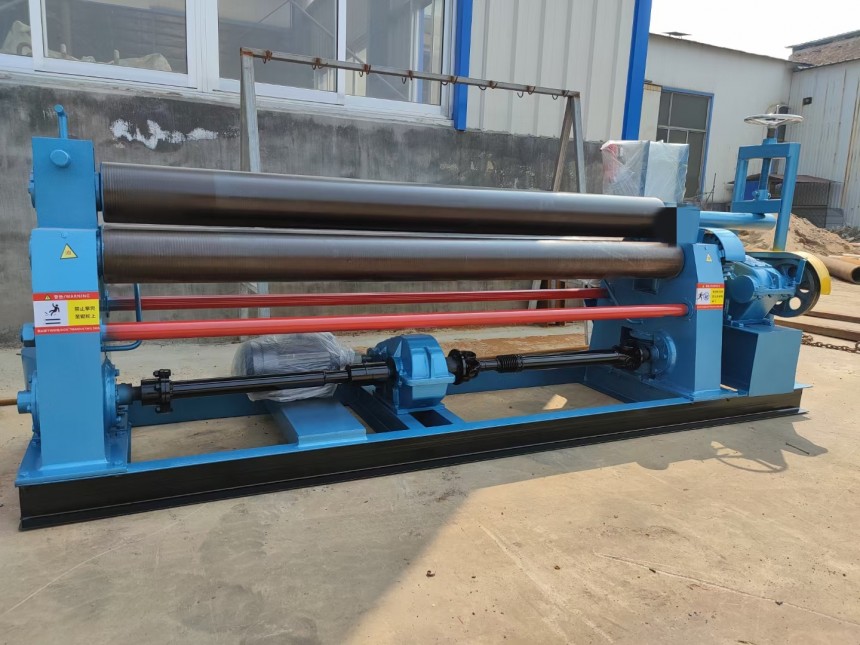

We are a professional roll plate machine manufacturer with over 10 years of industry experience. Today, we would like to introduce the on-site repair process for surface scratches on roll plate machine roll shafts:

roll plate machines are essential equipment in metal sheet processing. Their rollers are in constant contact with metal sheets, and their surfaces are prone to scratches caused by friction or foreign object compression. If these scratches are not repaired promptly, they can affect the quality of sheet forming and even lead to further wear of the rollers. Since disassembling the rollers for factory repairs is costly and time-consuming, on-site repair has become a more efficient option. The following introduces a practical on-site repair process.
1. Scratch detection and assessment
Before repair, thoroughly inspect the surface of the roller shaft to confirm the location, depth, and extent of the scratches. Minor scratches are typically less than 0.2 mm deep and only affect surface finish. Deeper scratches may be accompanied by localized pits or material spalling and require targeted treatment. Use strong light or magnetic particle inspection during inspection to ensure that no fine cracks are overlooked. If the edges of the scratches have raised areas or burrs, these should be ground smooth first to prevent incomplete subsequent treatment.
2. Surface pretreatment
The effectiveness of the repair process is largely dependent on the quality of surface cleaning. First, use a specialized cleaner to remove oil and dust from the roller shaft surface. Then, wipe with acetone or alcohol to ensure no residue remains. For rusted areas, use sandpaper or a small angle grinder to lightly sand until the metal base color is exposed. If scratches contain embedded impurities, use a fine steel needle or specialized tool to remove them, preventing the formation of pores or poor adhesion after repair.
3.Selection of repair materials
Common repair methods used on-site include cold welding, metal repair compounds, or laser cladding technology. Cold welding is suitable for shallow scratches, using low-temperature welding rods to fill defects, with simple operation and minimal thermal impact on the roller shaft substrate; metal repair compounds are suitable for small scratches in non-load-bearing areas, requiring grinding and polishing after curing; laser cladding offers high precision but requires specialized equipment support. When making an actual selection, it is necessary to comprehensively consider the severity of the scratches, equipment conditions, and strength requirements after repair.
4. Scratch Filling and Forming
If cold welding is used, welding should be performed in sections to avoid localized overheating. After welding each section, immediately tap it lightly with a hammer to release stress, then use a fine file to smooth the weld seam. For deeper scratches, layered filling is required, with each layer not exceeding 0.5 millimeters in thickness, and slag removed between layers. When using a repair compound, mix the base material and hardener in the specified ratio, then press the compound into the scratch using a scraper, ensuring it is slightly higher than the surrounding surface to ensure full filling. The operating environment temperature should be maintained above 5°C, with humidity below 70%, to ensure proper curing.
5.Post-processing and inspection
After the filler material has completely cured, first use coarse sandpaper (80-120 grit) for preliminary leveling, then switch to fine sandpaper (400 grit or higher) for precision grinding, and finally use a wool wheel with polishing compound to achieve a mirror finish. The repaired area must transition smoothly with the original surface of the roller shaft, with no noticeable steps to the touch. After completion, perform another non-destructive testing inspection to confirm there are no unresolved micro-cracks or pores. For high-precision rollers, use a dial indicator to measure radial runout, with deviations controlled within 0.05 millimeters.
6. Rust prevention and maintenance recommendations
The surface of the repaired roller shaft should be coated with rust-preventive oil, and contact with water or corrosive media should be avoided in the short term. During daily use, metal shavings remaining on the roller surface should be cleaned regularly, and lubrication should be increased appropriately when processing hard plates. If scratches repeatedly appear, check whether there are burrs on the edges of the plates or misalignment of the equipment to reduce damage at the source.
On-site repairs can significantly extend the service life of rollers, but strict adherence to the process steps is required. For damage deeper than 1 mm or accompanied by structural cracks, it is still recommended to replace the rollers to ensure safety. Through standardized operations and regular maintenance, the impact of scratches on production can be minimized.
If you are interested in our roll plate machines, please contact us.
 Address:Room 1202, Detaitang Building, No. 118 Huaguang Road, Zhangdian District, Zibo, Shandong
Address:Room 1202, Detaitang Building, No. 118 Huaguang Road, Zhangdian District, Zibo, Shandong WhatsApp:+8615653328535
WhatsApp:+8615653328535 Wechat: +8615965331535
Wechat: +8615965331535  E-mail:zs@sdsmachinery.com
E-mail:zs@sdsmachinery.com